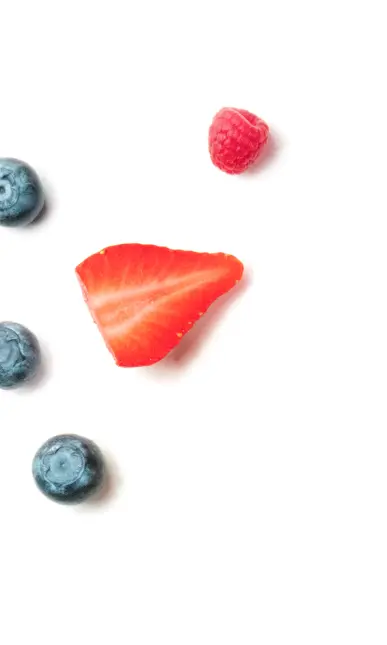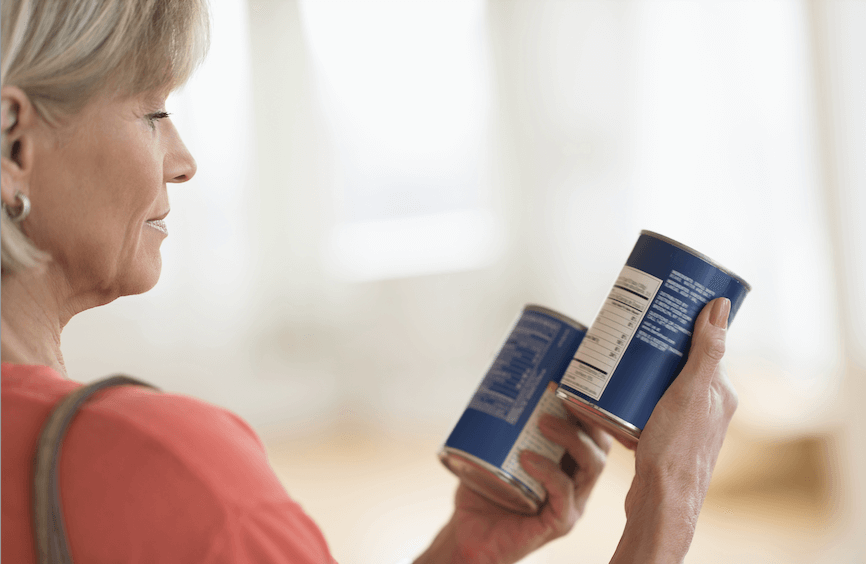
Understanding Food Labels and Knowing How to Use Them
Years back, people could just check food labels for the quantity of saturated fat and sugar to determine if they were buying healthy food that wouldn’t have any negative consequences when they eat. These days, food manufacturers try to influence these decisions by projecting their products as healthy foods since consumers are now bent on eating healthier foods and keeping their weight in check. Sadly, this has worked to a certain extent as people now eat and make poorly informed food choices.
These developments necessitate the need to accurately interpret and understand food labels. This guide aims to help packaged foods lovers make healthier choices in 2021 by introducing the essential and subtler nutrition facts labels carry. It also throws light on the updated nutrition facts label proposed by the US Food and Drug Administration (FDA).
How to Understand a Food Nutrition Facts Label
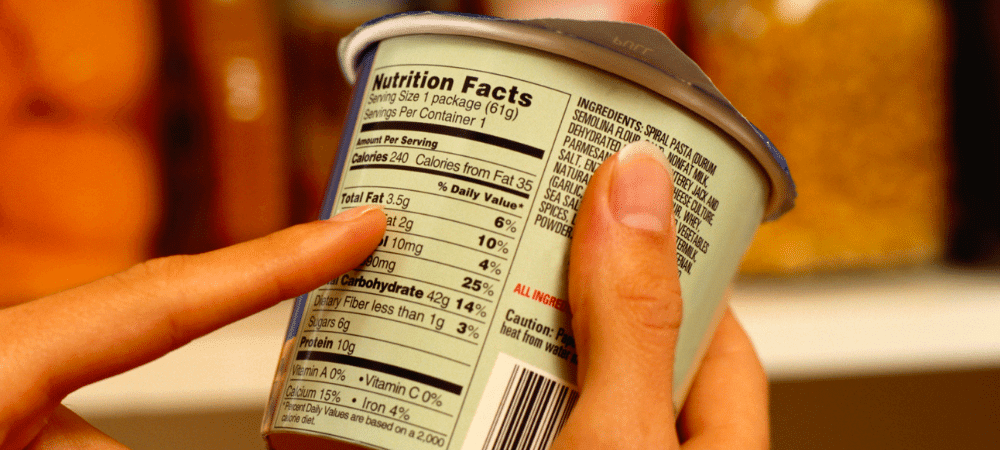
Source: UNL
It’s safe to say that knowing how to read food labels is a significant challenge for some. However, here are some tips to help you differentiate between wrongly labeled products and genuine ones.
Beat the Trick
If there’s anything consumers must know about food labels, it’s that the hidden facts are never visible, and most, if not all, product brands will never talk about them. The truth is that manufacturers know that customers are now highly conscious about getting fewer calories, and their product may not be the best to eat.
They have also responded with higher censoring and sometimes outright trickery to retain brand loyalty among their many consumers and keep sales. In recent years, there have been subtle changes in some of the world’s biggest food brands. For example, brands known for unhealthy sugar-concentrated snack foods now claim their products are healthy to eat.
While these changes are always projected as accurate, the reality is that most are just tactical health claims (which are legal) to get customers. There may be several changes, but most modifications don’t significantly reduce the negative consequences posed on health.
The following sections highlight some of the recent food nutrition labels’ tricks companies adopt and how they prevent consumers from making healthy choices.
Ignore False Front Package Claims

Source: Naked Food
Food contributes to a person’s overall shape and health. Therefore, it’s not surprising that people try to know how many calories they are consuming and if they are getting enough vitamins (vitamin D especially and other good nutrients).
However, many manufacturers know that consumers can only tell if they are getting the right amount of total fat and not lacking a particular nutrient when they read the nutrition facts label of food products. As such, their primary strategy is to stop or at least dissuade them from doing so. One of the best ways to achieve their goal is by boldly presenting nutrient content claims on front packages.
Research proves that front package claims influence buyers’ choices significantly. According to a review by PubMed, the Multiple Light Tracking system—which involves using different color codings systems to identify the various variables (food nutrients)—helps consumers select healthier food options.
Still, customers are more likely to choose foods with stated health claims (in most cases, unproven nutrition facts) than the same food product with no health claims on its label. Research confirms that customers pay attention to claims about how products regulate health conditions and ignore nutrition information listed separately on the label.
The issue with these claims is that most are deceptive. For example, irrespective of how much a nutrient the so-called peak quality cocoa puffs now offer, its major nutrients include sodium and added sugars. These could increase cholesterol levels and cause health problems in the long run (e.g., heart disorders).
Hence, customers must always ensure they choose foods based on nutrition facts and not ambiguous written claims.
Ingredients Listing Is Extremely Important
A good way to avoid tricky food labels is to examine the ingredients list. In most cases, the ingredients are listed in a descending order (highest to lowest quantities). Hence, it’s always a good idea to glance through the first three ingredients as they indicate the bulk of the food’s contents.
Food products that have saturated fats, sugars, or refined grains among its first few products may imply an unhealthy food option.
Knowing How to Read Nutrition Facts on Food Labels
Knowing how to read a nutrition facts label is the basics of getting the best out of a product’s nutrition facts and creating better dietary guidelines.
Food labels examples generally have a pattern, and they are sometimes not self-explanatory. However, the foundational basics that customers must have are that two same products with alternative names or different brands can offer varying numbers of calories and nutrients based on equal serving sizes.
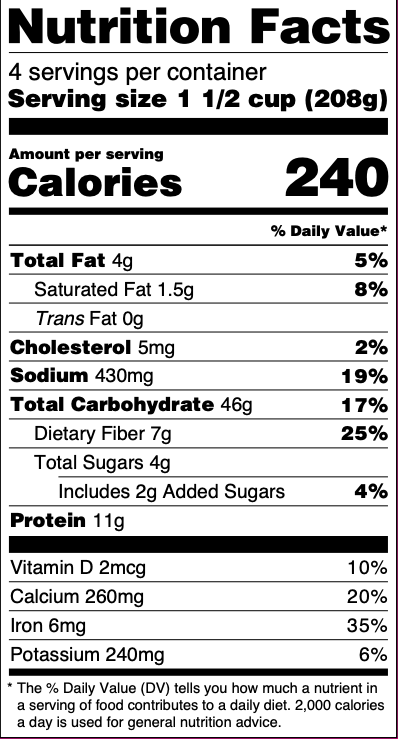
Source: HSPH
The above label will be used as an example for better clarification.
Servings per Container
The number of servings per container is stated to be four (4). This means that you’ll be able to use this food product on four occasions if you stick to the stated serving size.
Serving Size
The serving size on the above food label is stated as 1½ cup (280g). This is not the recommended amount you’re required to take; it’s only an indication of what the average person will take. Also, the number of servings per food product is calculated based on the stated serving size.
The Expected Calories
An excellent understanding of how to read food labels depends on your knowledge of calories.
The emboldened calorie value of 240 is the expected amount of calories for each serving. This means that the total calories in the container will be 240 x 4 = 960 calories. A higher calorie intake is associated with obesity. As a rule of thumb, the average human should stick to a 2,000-calorie daily diet.
Nutrients
The different nutrients contained in the food product are listed with their corresponding %DV. The nutrients listed first (e.g., total fat, cholesterol, sodium, etc.) are the major nutrients, while the others listed below (e.g., vitamin D, calcium, etc.) are the micronutrients.
Percent Daily Value (%DV)
The %DV is simply an indication of the daily value percentage for each nutrient based on the stated serving size. In other words, it implies how much each nutrient contributes to your total daily diet. A %DV of 5% or less is considered low, while a %DV of 20% or more is deemed to be high.
Ideally, you should aim for a higher %DV of beneficial nutrients like dietary fiber, calcium, vitamin D, potassium, and iron. On the other hand, you should aim for a lower %DV of nutrients like saturated fats, added sugars, and sodium since they’re linked to adverse health effects like cardiovascular disease.
The New Food and Drug Administration (FDA) Updated Label
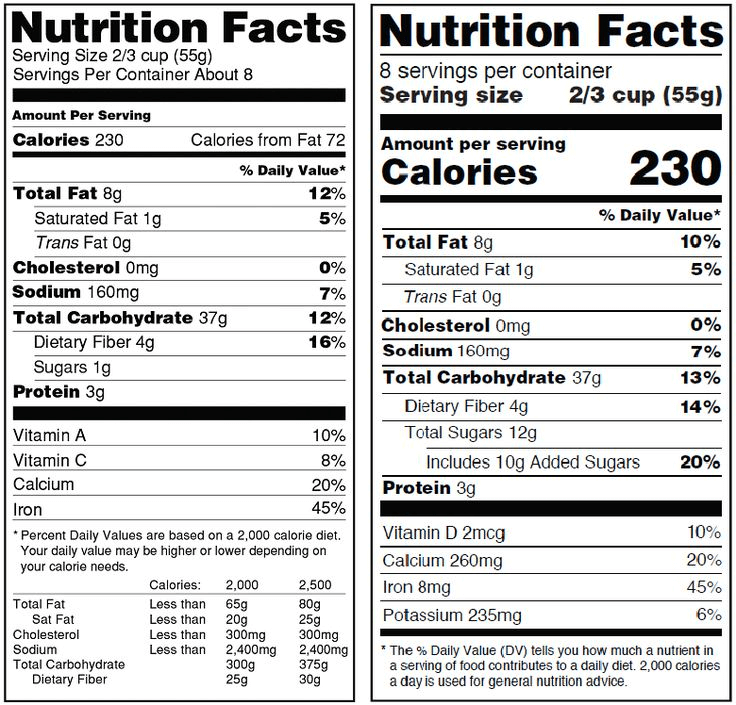
Source: Pinterest
The food labels examples above represent the old food labeling system and the currently updated FDA food label. In this section, we highlight the significant changes between the two.
Emboldened Calorie Counts
The calorie is made much more visible so consumers can easily read and know what to expect. Since calorie monitoring is a means to watch your weight, a larger font should make people more conscious of just how many calories they’re consuming.
Emboldened and Realistic Serving size
One of the tricks manufacturers used for labeling was an unrealistic serving size. Most did this to obscure just how much unhealthy fats customers may consume at once. Hence, rather than use a serving size based on how much the average person should consume, they are now based on just how much the average person realistically consumes.
To put things in perspective, one serving of ice cream was upgraded from ½ cup (66 g) to ⅔ cup (88 g). Also, the serving size is now more visibly stated and in bold fonts.
Added Sugars Included
Comparing the two food nutrition labels, it’s clear that the former label only showed the amount of sugar in a product (natural and artificial sugar). However, with the new updates, companies are obligated to separately outline the added artificial sugar added during processing alongside its %DV.
This modification is essential since added sugars are a risk factor for numerous health conditions like type 2 diabetes, obesity, heart disease, etc.
Modifications to Micronutrients
Under the micronutrients, new additions such as vitamin D and potassium (alongside their respective %DV) have been included in the updated nutrition facts label due to their benefits for bone strengthening and regulating blood pressure, respectively.
Also, manufacturers are no longer mandated to include micronutrients like vitamins A and C. This is because their deficiency is rare, and a plethora of food sources offer these nutrients in abundant quantities.
Modifications to Fats
In previous labels, calories from fats were differentiated from other calories. The FDA believed that such differentiation would help people know which products to go for. However, research has shown that fats’ calories do not make any significant difference as it is still calories.
In addition, a study showed that the type of fat in a product is of more significant consequence than calorie counts. Hence, the FDA now calculates calories generally and ensures that the type of fats (saturated fats, trans fat, e.t.c.) in products are always stated.
Modifications to the Footnote
A modified footnote in the new FDA food label explains the %DV and its implications more explicitly. The old food label only indicated that the %DV is calculated in relation to a 2000-calorie diet. However, the updated food label emphasizes that the 2,000-calorie per day recommendation is only general nutrition advice.
Conclusion
There are so many unhealthy foods in the markets, and it has become increasingly difficult for customers to get healthy foods. However, understanding food labels and the changes that have been made in recent times is an excellent way to start. Moreover, certain fitness organizations use food labels to help their clients/user base live better and make healthier food choices.
Our amazing app, Klinio, is one of the top health and fitness reseources with an excellent reputation in helping consumers plan better meal serving. Namely, it provides users with tips on how to get the optimal %DV from a minimal number of servings.
That’s not all; Klinio also encourages users to make better food choices through nutrition information in a nutrition facts label and limit sodium and added sugars consumption. Finally, when you use Klinio, you stand to benefit from pro tips that guide you to consume food products with naturally occurring sugars and other nutrients great for health.







